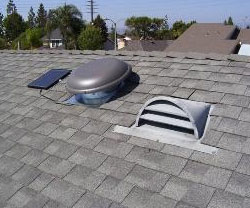Attic Ventilation
Many homeowners are unaware of how hot their attic gets during the day. While this may seem like it’s simply a minor inconvenience, it can actually be a significant problem. If you own a home and have an attic that isn’t properly ventilated, you need to learn why this is actually an issue, as well as what you can do to resolve it.
What Issues are Associated with Poor Attic Ventilation?
There are two primary issues that stem from poor attic ventilation. The first is the inability to keep this space’s temperature in a reasonable range. Without ventilation, an attic can become the hottest part of a home. When this space gets extremely hot, it eventually spreads to other areas of your home. Since you don’t want your home to feel like a sauna, you have to spend extra money on energy to keep your home cool. And because the attic can reach such hot temperatures, this excess heat can cause expansion that leads to everything from structural elements being damaged to your roof wearing down sooner than it should.
The other major issue that can result from inadequate ventilation is the accumulation of moisture. Once moisture begins building up in this space, it can take as little as seventy-two hours for mold to begin growing. Because mold can grow and spread so quickly, it can be very expensive to remove. Additionally, since it may be hard to detect, a large mold problem that goes unnoticed can cause breathing complications for anyone who’s living in your home.
How Can Attic Ventilation Be Improved?
If you’re concerned because your attic currently doesn’t feature adequate ventilation, the good news is it’s fairly easy to remedy this situation. There are several ways that you can ventilate this space and avoid the problems that go along with not taking action. These options include ventilators that operate by:
- Gravity
- Wind
- Power
Gravity attic ventilation works by taking advantage of the fact that hot air rises. As a result, two types of vents can be placed at different levels to bring in fresh air and allow hot air to escape. The appeal of wind ventilation comes from the fact that it uses less space to achieve the same efficiency as gravity ventilation. And the reason some homeowners choose power ventilation is because it makes it possible to control temperature and moisture levels in even the most challenging of spaces.
Is Natural or Power Ventilation a Better Choice for Your Attic?
The reason that most homeowners choose gravity or wind ventilation for their attic is because these methods don’t consume any additional energy. In fact, because they keep attic air from getting too hot, they can actually reduce the amount of energy that a home currently uses. While power ventilation can work well in attics with designs that create a challenging situation, it’s important to remember that this type of system will cost money to run. As a result, it’s best to choose a natural ventilation option unless your attic specifically requires power ventilation.

Categories
- Home
- Types Of Loft Ventilation
- Attic Ventilation
- Heat Recovery Ventilation
- Industrial Loft Ventilation
- Loft Roof Space Ventilation
- Natural Ventilation
- Pigeon Loft Ventilation
- Positive Pressure Loft Ventilation System
- Proper Roof Ventilation
- Roof Ventilation
- Soffit Loft Ventilation
- Solar Ventilation
- Loft Ventilation Companies
- Loft Ventilation Information
- Loft Ventilation Products
